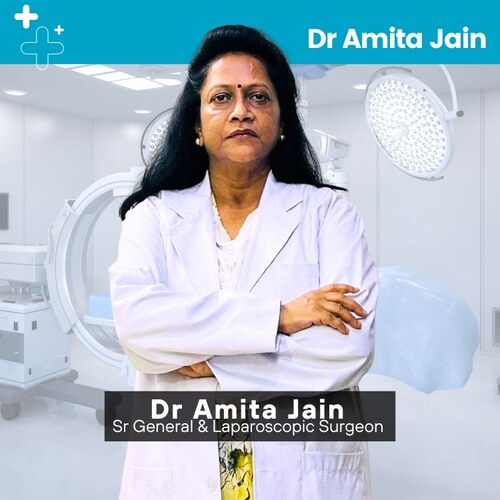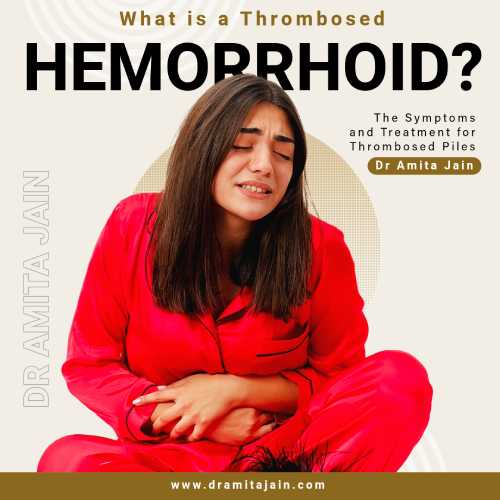We have all come across the term “Hemorrhoids” or “piles” at some point in our lives. These are swollen veins located in the rectum and lower rectum.
Depending on where they develop, hemorrhoids are classified into two main types: internal hemorrhoids, which form inside the rectum, and external hemorrhoids, which develop under the skin around the rectum.
In addition to these two types, there are prolapsed hemorrhoids, which extend outside the rectum opening, and thrombosed hemorrhoids, which are external hemorrhoids that have developed a blood clot.
Today, we are going to learn about the symptoms and treatment for Thrombosed Hemorrhoids from renowned laparoscopic surgeon, and piles specialist in Delhi Dr Amita Jain.
What is a Thrombosed Hemorrhoid?
A thrombosed hemorrhoid, also known as acute hemorrhoidal disease or perirectum thrombosis, is a condition that occurs when a blood clot forms within a hemorrhoid, leading to significant swelling and pain.
This often results in the hemorrhoid appearing as a swollen or bluish lump, which can manifest as either a single lump or a cluster of lumps.
While this condition can be quite uncomfortable, the body typically reabsorbs the clot over time, leading to a gradual resolution of symptoms.
What is the Difference Between Regular Hemorrhoid vs. Thrombosed Hemorrhoid?
Thrombosed hemorrhoids are marked by severe pain in the perineal region and a painful lump near the rectum.
Unlike non-thrombosed external hemorrhoids, which are soft and rubbery, thrombosed hemorrhoids typically exhibit a blue or purple discoloration, indicating the presence of a blood clot within the affected area.
What are the Symptoms of Thrombosed Hemorrhoids?
It is important to know the symptoms of thrombosed hemorrhoids to seek appropriate treatment. The key symptoms include:
- Pain: Individuals often experience significant pain when sitting, walking, or during bowel movements. This pain is typically most intense within the first 24 to 48 hours.
- Itching: There may be itching or irritation around the rectum area, which can add to the discomfort.
- Bleeding: Some people may notice bleeding during bowel movements, which can occur due to the pressure on the affected area.
- Swelling or Lumps: Thrombosed hemorrhoids can cause noticeable swelling or lumps around the rectum, which may be tender to the touch.
- Infection Risk: In some cases, thrombosed hemorrhoids can become infected, leading to additional symptoms such as fever.
- Pain Location: Unlike surface pain relieved by over-the-counter topical hemorrhoid medications, the pain from a thrombosed hemorrhoid originates from internal pressure and swelling within the tissue.
- Understanding these symptoms can help individuals recognize the condition and seek medical advice if necessary.
What is the Diagnosis?
- Clinical Evaluation: Thrombosed external hemorrhoids are primarily diagnosed through a thorough clinical assessment.
- Patient History: Patients typically report a sudden onset of intense pain in the rectum region, which is a key indicator of thrombosed hemorrhoids.
- Physical Examination: During the physical exam, a healthcare provider will look for a painful lump or swelling in the perirectum area, which is characteristic of thrombosis.
- Visual Inspection: A visual inspection of the rectum helps to rule out the presence of prolapsing internal hemorrhoids, ensuring an accurate diagnosis.
- Digital Rectal Examination: A digital rectal exam may be conducted to check for blood in the stool and to exclude any rectal masses or internal hemorrhoids.
- Anoscopy: If the digital rectal exam is inconclusive, an anoscope—a small illuminated speculum—can be used to visualize the lower rectum for a more definitive diagnosis.
What is the Treatment?
Treatment for a thrombosed hemorrhoid depends on how long symptoms have lasted. If it’s within 48-72 hours, a doctor can remove the clot with a small incision under local anesthesia, usually without stitches, relieving pain.
If it’s been longer than 72 hours, home remedies may be recommended for pain relief.
However, in case the bleeding continues or there is excessive pain, the following surgical options may be recommended by the doctors:
Hemorrhoidectomy: Surgical removal of hemorrhoids, including blood vessels and clots, under general anesthesia; reserved for severe cases due to its invasive nature.
Banding: An elastic band is placed around the hemorrhoid’s base, cutting off blood supply, leading to its fall-off within 3-7 days.
Stapled Hemorrhoidopexy: Involves stapling hemorrhoids in place under general anesthesia; typically used for large or prolapsed hemorrhoids unresponsive to other treatments.
Are there any Home Remedies?
Some home remedies could include:
- The application of over-the-counter ointments can help relieve the discomfort.
- Soaking the affected area in warm water several times a day and gently patting it dry may help ease discomfort.
- Ice Pack or cold compress can be applied to the affected area.
- Stool softeners or fiber supplements will help ease bowel movements.
Now that you know the symptoms and treatment options for thrombosed hemorrhoids, recognizing early signs like pain, swelling, and bleeding can prompt timely medical attention.
Treatment ranges from home remedies like warm baths and ointments to medical interventions such as clot removal or surgical procedures, depending on the severity and duration of symptoms.

Dr Amita Jain is one of the most experienced and highly skilled general and laparoscopic surgeons in Delhi and India. Known for her exceptional surgical precision and patient-first approach, she offers expert care across a wide range of procedures, using both open and minimally invasive techniques to ensure faster recovery and better outcomes. Dr Amita Jain holds 28 plus years of rich experience in Trauma and General Laparoscopic Surgeries (including Gallbladder stone removal, appendix removal, hernia repair surgery, piles and fissure surgeries). She was the Professor Surgery of at the Army College of Medical Sciences. In 1994 she was commissioned as Surgeon under the United Nations Mission in Congo. From 2020 to 2022, she worked with Bansals Hospital. Currently, Dr Amita Jain is the Sr. General and Laparoscopic Surgeon at Rainbow Children Hospitals, Malviya Nagar, Delhi.
As a top female surgeon in Delhi, Dr Amita Jain brings decades of experience, compassion, and a commitment to surgical excellence. She has undergone advanced training in trauma surgery and has successfully performed numerous complex procedures, including life-saving surgeries, vascular repairs, mangled limb reconstructions, and critical care surgeries. Whether it’s a planned surgery or an emergency situation, patients across Delhi trust Dr Amita Jain for her expertise, integrity, and results-driven approach to general and laparoscopic surgery.
Call Us at +(91) 882-6615301
